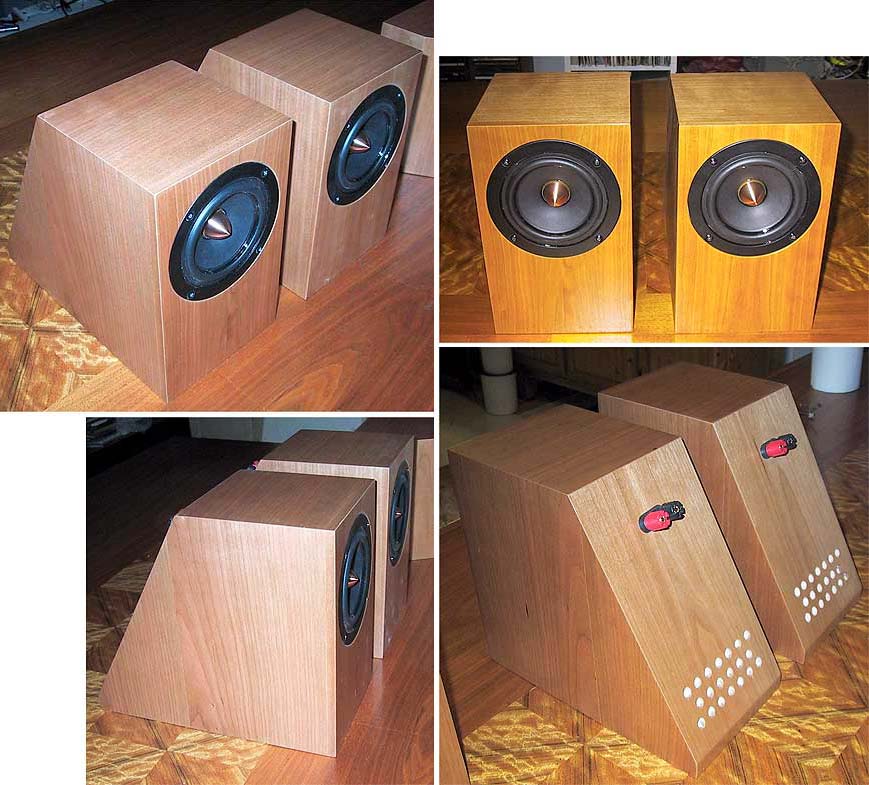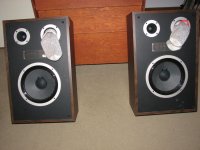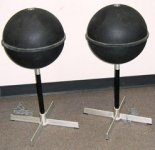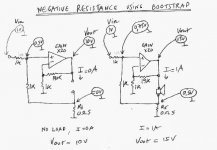There is something I find annoying about all my speakers:
For signals approaching the speakers resonant frequency there is a peak in response in a muddy/boomy/annoying way. It only vaguely resembles the original sound and it continues for a fraction of a second after the input signal stops.
From what I have read it looks like too high Q, or not enough damping.
Any help on how to fix it?
A parametric equalizer / notch filter to cut down the offending frequency?
Does adding more soft stuff inside the box increase mechanical damping? What materials can be used?
Is there a way to increase electrical damping? Can I add a parallel 8Ohm resistor to 8Ohm speakers when used with a 4Ohm-capable amplifier?
I don't want a lot of bass, just reasonably flat response down to a point and then smooth roll-off. Is this too much to ask?
Thanks
kanguru007
For signals approaching the speakers resonant frequency there is a peak in response in a muddy/boomy/annoying way. It only vaguely resembles the original sound and it continues for a fraction of a second after the input signal stops.
From what I have read it looks like too high Q, or not enough damping.
Any help on how to fix it?
A parametric equalizer / notch filter to cut down the offending frequency?
Does adding more soft stuff inside the box increase mechanical damping? What materials can be used?
Is there a way to increase electrical damping? Can I add a parallel 8Ohm resistor to 8Ohm speakers when used with a 4Ohm-capable amplifier?
I don't want a lot of bass, just reasonably flat response down to a point and then smooth roll-off. Is this too much to ask?
Thanks
kanguru007
Hi
1) plug or stuff the port.
2) No port then add increasing amounts of acoustic stuffing fiberglass or polyfill>
3) Still not enough then add increasing amount of series resistance 0.5 - 2 ohms.
4) Still not enough and don't want to do step 3), then drill a few smaller holes in back panel and cover with a few layers of cloth.
heehee or we can get a load of more info from you and get our calculators out.😉
1) plug or stuff the port.
2) No port then add increasing amounts of acoustic stuffing fiberglass or polyfill>
3) Still not enough then add increasing amount of series resistance 0.5 - 2 ohms.
4) Still not enough and don't want to do step 3), then drill a few smaller holes in back panel and cover with a few layers of cloth.
heehee or we can get a load of more info from you and get our calculators out.😉
Attachments
That was quick... Cal just posted that pic in another thread.
There are better things than socks. I like using low-medium density foam (i have lots), Same for the aperiodic ports in option 4. BTW 4/ is a more rigorous application of 1/. Probably be a good idea to seal the port.

My feeling is that 3/ will probably take you in the wrong direction.
dave
There are better things than socks. I like using low-medium density foam (i have lots), Same for the aperiodic ports in option 4. BTW 4/ is a more rigorous application of 1/. Probably be a good idea to seal the port.

My feeling is that 3/ will probably take you in the wrong direction.
dave
planet10 said:That was quick... Cal kust posted that pic in another thread.
My feeling is that 3/ will probably take you in the wrong direction.
dave
Saw the pic and thought it fit the shoe so to speak.
Option 3 raises Qes and thus Qts and higher Q for a fixed enclosure volume is not needed here.
Also stuffing too close to the cone raises Qms and usually more slightly Qts too.
Q is inversely related to damping ie higher Q is less damping.
Dave how do you get that 104K image to display large (ie not a smaller thumbnail)
infinia said:Q is inversely related to damping ie higher Q is less damping.
Right. And higher Q is more boom.
dave
planet10 said:
Right. And higher Q is more boom.
dave
and i just thought it was Fpk/BW for a 2nd order system.😉
Dave how do you get that 104K image to display large (ie not a smaller thumbnail)
infinia said:Dave how do you get that 104K image to display large (ie not a smaller thumbnail)
It is sitting in some of my webspace (in this case on some of Apple's servers)
http://p10hifi.net/tlinespeakers/FAL/images/4L-aperiodic-FR125.jpg
dave
A to small bass reflex port can sound boomy, or a to long pipe.
Because the pipe ads acoustic resistance on its tuning frequency and so prevents the speaker to resonate.
When the port is to small the pipe will not add enough load to the resonating speaker and the damping will be poor.
Because the pipe ads acoustic resistance on its tuning frequency and so prevents the speaker to resonate.
When the port is to small the pipe will not add enough load to the resonating speaker and the damping will be poor.
Sorry, I should have been more specific. I'm using closed speakers, a pair of 1969 Nivico GB-1E speakers (with 4 small but good-looking paper cone, cloth surround, cast aluminum chassis woofers). They resonate at a low frequency so boomy is not the word to describe their peak but they still have a peak at resonance.
kanguru007 said:Sorry, I should have been more specific. I'm using closed speakers, a pair of 1969 Nivico GB-1E speakers (with 4 small but good-looking paper cone, cloth surround, cast aluminum chassis woofers). They resonate at a low frequency so boomy is not the word to describe their peak but they still have a peak at resonance.
Then increase the volume of the box,and then stuff it loose till the right sound is there.
Do not place them near floor or corner or wall but a few meter of the wall.
Place them on a stand about 40cm > of the floor.
Sound like the perfect excuse to build a new set speakers.
Here a design of pair very tight sounding speakers.tight
Hi,
Seems the only thing you can do is increase stuffing.
Option 3 is wrong, it takes you in the wrong direction.
IMO your best bet is to add a subwoofer and bass
filter the feed to the GB-1E's, which should fix the
problem and give you proper low bass to boot.
🙂/sreten.
Seems the only thing you can do is increase stuffing.
Option 3 is wrong, it takes you in the wrong direction.
IMO your best bet is to add a subwoofer and bass
filter the feed to the GB-1E's, which should fix the
problem and give you proper low bass to boot.
🙂/sreten.
Attachments
sreten said:
Seems the only thing you can do is increase stuffing.
The original material on the speakers is made of thin gray fibers with color spots and it slowly melts when heated up to 300 Centigrad, polyester maybe? It is 40 years old, maybe there are better stuffing materials available today. Is fiberglass the only good stuffing thing for damping?
I have just tried adding 50% more stuffing, borrowed from another GB-1E set, and the problem has definitely improved. It is better than before but still not flat: one bass guitar note still sounds higher.
sreten said:
IMO your best bet is to add a subwoofer and bass
filter the feed to the GB-1E's, which should fix the
problem and give you proper low bass to boot.
All subwoofers I tried were bad, like 20 times worse than these speakers. One $600 Yamaha kept making its 60Hz boomy sound for a full second after the signal was gone, and wouldn't go much lower than 40Hz. I did not spend $2000 on a Velodyne or Sunfire so I'm still curious about those.
The GB-1E bass response is good (although the claimed 20Hz-20KHz response is probably exagerated). I just want to get rid of the resonance peak.
There is a 2mm venting hole on the back of each woofer. Stuffing it with cotton wool would restrict air flow and could provide some further damping, what do you think?
There's a web page of a guy who used cotton wool on several kinds of tweeter to damp the back chamber air flow and he got flatter response from all of them.
kanguru007
There's a web page of a guy who used cotton wool on several kinds of tweeter to damp the back chamber air flow and he got flatter response from all of them.
kanguru007
Hi,
Well if bass extension per se is good then your only option IMO
is an adjustable 2nd order notch filter set to the box frequency.
You could build this around the power amplifier feedback
loop treating it as an op-amp or build it into a line stage.
As you stuff Fbox should drop, too much it starts going back up.
🙂/sreten.
Well if bass extension per se is good then your only option IMO
is an adjustable 2nd order notch filter set to the box frequency.
You could build this around the power amplifier feedback
loop treating it as an op-amp or build it into a line stage.
As you stuff Fbox should drop, too much it starts going back up.
🙂/sreten.
---Is there a way to increase electrical damping?---
Depends on your skills in electronics.
Using damping materials, you only increase the mechanical damping.
To control electrical damping, you have to go throught electrical ways.
Using a negative resistance amplifier, you can easily halve the Q of any driver.
An other way, only valid for closed boxes, is to use a notch or a "bell" correction if have a driver digital processor (Berhinger, BSS and the like).
Depends on your skills in electronics.
Using damping materials, you only increase the mechanical damping.
To control electrical damping, you have to go throught electrical ways.
Using a negative resistance amplifier, you can easily halve the Q of any driver.
An other way, only valid for closed boxes, is to use a notch or a "bell" correction if have a driver digital processor (Berhinger, BSS and the like).
Hi,
The negative resistance amplifier is more complicated than building
a notch filter into the amplifier and not recommended at all for full
range drive unless the particular driver or speaker suits.
🙂/sreten.
The negative resistance amplifier is more complicated than building
a notch filter into the amplifier and not recommended at all for full
range drive unless the particular driver or speaker suits.
🙂/sreten.
There are some new pretty effectibe damping materials available... This is one that has popped up a couple times that looks interesting. http://www.eltim.eu/index.php?action=extra&extra=new_twaron__angel_hair__damping_material&lang=EN
Since the box is sealed, a high Q bass is simply a matter of too small a box. Adding stuffing increases the apparent volume of the box but only 20-30% maximum,
KEF has just patented a technique that uses activated charcoal to take the idea further.
What i usually do in a situation like this is to make the box aperiodic (the damped series of small holes mentioned above)
dave
Since the box is sealed, a high Q bass is simply a matter of too small a box. Adding stuffing increases the apparent volume of the box but only 20-30% maximum,
KEF has just patented a technique that uses activated charcoal to take the idea further.
What i usually do in a situation like this is to make the box aperiodic (the damped series of small holes mentioned above)
dave
kanguru007 said:One $600 Yamaha kept making its 60Hz boomy sound for a full second after the signal was gone
That sounds very excessive. How are you testing to get this result?
Hi
A line level parametric EQ could be a better choice for most, rather than some custom time consuming, costly, and even dangerous electrical methods suggested above.
see http://www.marchandelec.com/wm8.html
A line level parametric EQ could be a better choice for most, rather than some custom time consuming, costly, and even dangerous electrical methods suggested above.
see http://www.marchandelec.com/wm8.html
Hi Sreten,
Negative resistance can be easy to implement.
I've been using this one for some time.
It needs a low impedance source.
I also experienced the Sokol adjustable transform for closed speakers.
Both worked well. I am currently using a digital processor with which Q of speakers can set at almost any value.
Negative resistance can be easy to implement.
I've been using this one for some time.
It needs a low impedance source.
I also experienced the Sokol adjustable transform for closed speakers.
Both worked well. I am currently using a digital processor with which Q of speakers can set at almost any value.
Attachments
- Status
- Not open for further replies.
- Home
- Loudspeakers
- Multi-Way
- speakers operating near their resonant frequency


